Articles of 2009
Sugar Ray Leonard: He Took The Baton From Ali, And He Could Fight
He was named after singer Ray Charles and even called up the one and only Sugar Ray Robinson to ask if it was OK to borrow his moniker, “Sugar Ray.” When his boxing career concluded he would be best known for winning a gold medal during the 1976 Olympics and winning world titles in five different weight classes as a pro. Since Sugar Ray Robinson, born Walker Smith Jr., popularized the name, many fighters have adopted the ring name Sugar Ray. Only one of them has measured up to what the name stood for and represented: Sugar Ray Leonard. Without a doubt the realization of Ray Leonard exceeded the expectation as both a fighter and true superstar. It's also a fact that Sugar Ray Leonard carried boxing from the time Muhammad Ali retired.
As a fighter Sugar Ray Leonard had it all. He could box and he could punch. He was most identified by his blinding speed of hand and foot. Leonard was versatile and capable of fighting effectively inside or outside. Along with that he possessed a great chin and had the heart and the will to win comparable to any fighter in history. Something else that he had an abundance of was ring savvy. Sugar Ray Leonard was a ring genius who often implemented a Plan B, changing his attack plan during the fight. Sugar Ray Leonard also had a real killer-instinct and was at his most dangerous when his opponent was hurt or showed him too much respect. Once he had his opponent in trouble, he finished him off.
If fate hadn't smiled down on him enough, he just so happened to fight during one of the best non-heavyweight eras in boxing history, which afforded him the chance to measure himself against other great fighters and champions. His record is a virtual who's who list of great fighters.
If all of the above wasn't enough to make anyone envious, he also had crossover appeal and was arguably the biggest draw of any non-heavyweight fighter in boxing history. Sugar Ray Leonard is the fighter Oscar De La Hoya used for a career barometer and the fighter he most measured himself against, although he'd never admit it publicly.
After Sugar Ray Leonard won a gold medal at the 1976 Summer Olympics, he was brought to Hall Of Fame trainer Angelo Dundee to help guide and teach him the pro game, although Dundee only came in a week or so before his fights. What was it that Marvin Hagler said about him leading up to their fight in 1987? “He was named after Ray Charles, stole Sugar Ray Robinson's name, and had Ali's trainer.” What most don't know is that his trainer really was Janks Morton, who was aided by Dave Jacobs. But Morton was the one who had final say. Dundee just came to camp a week or two out from the fight to help Ray and Janks devise an attack strategy and fight plan for the opponent in the upcoming fight.
Some fans and media members found Sugar Ray Leonard hard to take and very condescending. He was good looking, had a shark for a business manager named Mike Trainer and was an overall media darling. Forget the image, Sugar Ray Leonard could flat out fight and must be given credit for being a truly all-time great fighter.
Fighting as a welterweight, Sugar Ray Leonard was as close to unbeatable as a fighter could be. Look who who gave him his only loss at 147–Roberto Duran, who is the best pound-for-pound fighter since Sugar Ray Robinson. It's been mentioned by some that Leonard fought hand-picked opponents during his career. This is wrong and in fact Leonard only faced two fighters who were under .500 when he fought them, and they were both within his first seven pro fights. On the way up the welterweight ranks Leonard was matched against fighters who had varying styles and more experience than he did. Leonard fought toughie Rafael Rodriguez, slick Floyd Mayweather Sr. who was 16-1, the durable Randy Shields, and three-time title challenger and veteran Armando Muniz before he challenged for the welterweight title.
Five months after stopping Muniz, Leonard decisioned middleweight Marcos Geraldo over 10 rounds. The same Geraldo would go the distance with top-ranked middleweight contender Marvin Hagler a short time later. In fairness, I must include that three years after losing to Leonard, Geraldo was KO'd by Thomas Hearns in one round. However, that was Hearns, and it's well known Hearns punched harder than either Leonard or Hagler. Before challenging for the welterweight title, Leonard stopped 30-3-1 junior middleweight Tony Chiaverini, and devastated third-ranked contender Andy “The Hawk” Price in one round on the Larry Holmes-Earnie Shavers title fight undercard.
After destroying Price, Leonard fought 38-0-1 WBC welterweight champ Wilfred Benitez. Benitez is the youngest fighter in history to win a world title, doing so at age 17. Leonard challenged Benitez 10 months after he took the title from Carlos Palomino. Wilfred was a master boxer who had radar for defense and made fighters miss him with their punches, including Leonard, without moving his feet. When Leonard and Benitez finally clashed, it was a chess match strategically. The difference was Leonard was the superior offensive fighter. Leonard took the title when the fight was stopped with only six seconds remaining in the 15th round. The stoppage was premature, but Leonard clearly showed during the fight that he was the better fighter and deserving of the title.
In his first defense of the title, Leonard scored one of the most chilling knockouts ever when he stopped former title challenger, 33-2 Dave “Boy” Green with a dynamite left hook to the chin in the fourth round. The Green KO was so brutal, some thought Leonard killed Green before their eyes.
In his second title defense, Leonard met former undisputed lightweight champion Roberto Duran, who was 71-1 and hadn't lost in eight years.
On June 20th 1980, Leonard and Duran met in what was titled “The Brawl For It All” in Montreal. Leading up to this fight, Duran did a number on Leonard psychologically by taunting his wife and making fun of him and challenging his manhood. Leonard already believed he could go through Duran before their fight; by the time they got into the ring he wanted to kill him. This played right into what Duran wanted. Roberto lured Ray into a toe-to-toe fight which he won via a close decision. Although Leonard lost, no one ever questioned his toughness again.
Five months later they met in a rematch, only this time Ray won the head game and totally frustrated Duran, making him say “no mas” in the eighth round to regain his WBC title. Leonard may have been the sharpest and fastest he ever was in his career during the rematch with Duran. He was totally wired and cat-quick. Anyone who's not sure or doesn't remember this, go back and watch the tape, I did. Seven months after winning the title back from Duran, Leonard stopped 36-0 Ayub Kalule, to win the WBA junior middleweight title. Shortly after winning the title, Leonard vacated it and went back down to welterweight, seeking the ultimate showdown.
Three months prior to Leonard beating Duran in their rematch, Thomas Hearns destroyed WBA champ Pipino Cuevas in two rounds to capture the title. Hearns was 32-0 (30) and a true killer who looked invincible at welterweight. On September 16th 1981, Leonard and Hearns met in what was the most highly anticipated welterweight championship fight in history, titled “The Showdown.”
In the fight, Hearns started off very fast, scoring with his long hard jab which kept Leonard from getting inside. Hearns clearly had the advantage for the first five rounds, and up until that time it looked as if he was too big and strong for Ray. In the sixth round, Leonard got inside and landed a stinging right uppercut that shook Hearns. From this point on, Hearns became the prey and Leonard the predator. However, Hearns regrouped and maintained his lead in the fight, due to his underrated boxing ability. Knowing that he was behind in the scoring, Leonard stormed out of his corner at the start of the 14th round and opened up with a flurry of punches, hurting Hearns. Leonard, being a tremendous finisher, never let Hearns recover, which led to the fight being stopped late in the 14th round.
After making one defense of the unified welterweight title against Bruce Finch, Leonard retired with a detached retina. Leonard came out of retirement 23 months later and stopped ranked Philly welterweight contender Kevin Howard after suffering the first knockdown of his career during the fight. Leonard retired again shortly after the Howard fight.
After not fighting since May of 1984, Ray was bitten by fighting again and came back to challenge undisputed middleweight champ Marvelous Marvin Hagler. Hagler had been ruling the middleweight division for seven years and was unbeaten over 11 years. Ray was laughed at when he told everyone that he could take Hagler's middleweight title despite never having fought above 154 pounds, and only fighting once in the past five years. Leonard entered the ring against Hagler on April 6th 1987 as more than a 3-1 underdog. A fight with Leonard was a fight Hagler longed for since Leonard retired in November of 1982, and he promised to “Destruct and Destroy” him.
In what is the biggest and supposedly the toughest fight of Leonard's career, he fought the most brilliant fight of his life. Look, this fight was very close. If you were rooting against Leonard, you can say he lost and really believe it in your heart. However, there can be no dispute that Leonard won the first three rounds, which cost Hagler the fight in my opinion. Hagler had to win seven of the last nine rounds and he didn't. This is the crowning moment of Ray's career; nobody ever thought this fight would be left up to the judges before the bell rang for the first round. Leonard had studied Hagler and knew exactly how to fight him. The boxing world thought the way to beat Hagler was to back him up, which Leonard showed was a fallacy. Hagler, being a counter puncher, was vulnerable, as I like to say, when he had to be the Joe Frazier in the fight.
After Hagler, Ray fought at a catch-weight of 168 and won the super middleweight and light heavyweight titles with a ninth-round stoppage of light heavyweight champ Donny LaLonde. After LaLonde, Leonard fought a rematch with Thomas Hearns that ended in a disputed draw. Hearns even dropped Leonard twice during the bout, but even that didn't eclipse the larger than life image of Sugar Ray. Shortly after the fight on the “Tonight Show” Leonard admitted that Hearns deserved the decision.
Six months after Hearns, Leonard fought Roberto Duran for the third time. This time both fighters were way past their best fighting days and Leonard handled Duran, who was making the first defense of the middleweight title he had won from Iran Barkley 10 months earlier. Ray retired after winning a decision over Duran, only to un-retire a year and a half later to fight Terry Norris at the junior middleweight limit of 154. Ray looked like an empty package and dead at the weight versus Norris. Norris proved to everyone who saw the fight that it was time for Ray to move on, giving him a one-sided thrashing over 12 rounds. Once again, Ray couldn't accept that it was over (none of the greats ever can, that's part of what makes them great), and after a six-year absence from the ring at age 41, he fought Hector Camacho and was stopped for the only time in his career in five rounds. Leonard retired for good after the Camacho debacle.
Like him or loathe him, Sugar Ray Leonard at his peak fighting as a welterweight is without question one of the greatest pound for pound fighters in fistic history. Fighting as a natural welterweight he could box or punch, trade and slug and had the heart of a wounded lion and sucked it up when he faced adversity.
I consider Sugar Ray Leonard the second greatest welterweight in history and would only pick Sugar Ray Robinson to beat him in a prime vs. prime confrontation.
Frank Lotierzo can be contacted at GlovedFist@Gmail.com
-
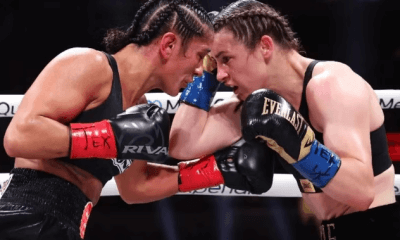
 Featured Articles3 weeks ago
Featured Articles3 weeks agoResults and Recaps from New York Where Taylor Edged Serrano Once Again
-

 Featured Articles1 week ago
Featured Articles1 week agoThe Hauser Report: Zayas-Garcia, Pacquiao, Usyk, and the NYSAC
-
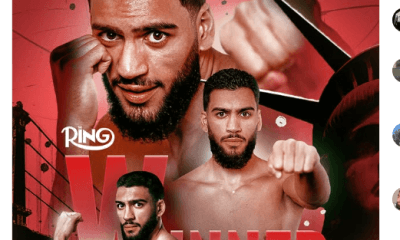
 Featured Articles3 weeks ago
Featured Articles3 weeks agoResults and Recaps from NYC where Hamzah Sheeraz was Spectacular
-

 Featured Articles2 days ago
Featured Articles2 days agoOscar Duarte and Regis Prograis Prevail on an Action-Packed Fight Card in Chicago
-
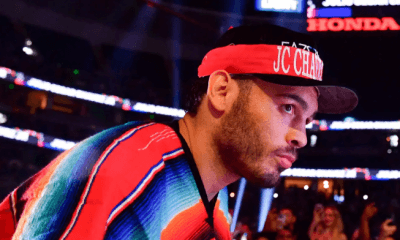
 Featured Articles4 weeks ago
Featured Articles4 weeks agoFrom a Sympathetic Figure to a Pariah: The Travails of Julio Cesar Chavez Jr
-
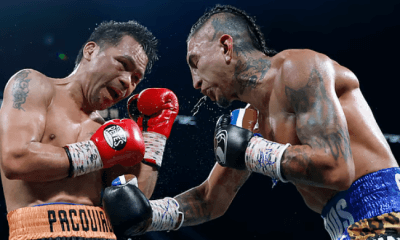
 Featured Articles2 weeks ago
Featured Articles2 weeks agoManny Pacquiao and Mario Barrios Fight to a Draw; Fundora stops Tim Tszyu
-
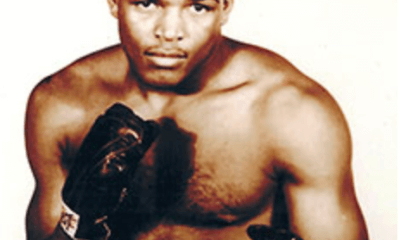
 Featured Articles3 weeks ago
Featured Articles3 weeks agoPhiladelphia Welterweight Gil Turner, a Phenom, Now Rests in an Unmarked Grave
-
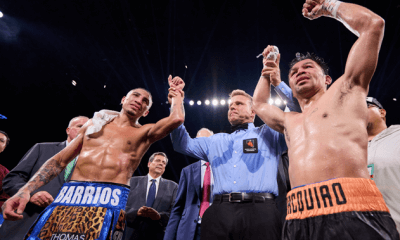
 Featured Articles2 weeks ago
Featured Articles2 weeks agoArne’s Almanac: Pacquiao-Barrios Redux
















